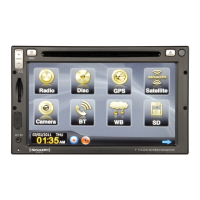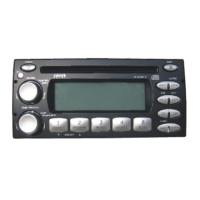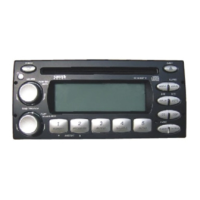Do you have a question about the Magnadyne M1-LCD and is the answer not in the manual?
Provides safety advice, regulatory compliance information, and handling precautions.
Details care, environmental considerations, and potential display issues for the LCD panel.
Explains the non-touch display area and its information elements like source and volume.
Describes the touch-activated area used for selecting audio and video sources.
Details the touch-activated buttons for navigation and basic settings.
Identifies and explains the functions of all buttons on the remote control.
Describes how to enable or disable audible feedback for button presses.
Adjusts tuner configuration for different geographic frequencies.
Allows changing the screen's background color from available options.
Explains how to activate the front camera view for display.
Sets the initial volume level when the unit powers on.
Manages the display of Radio Data System information like station names.
Controls the display of a clock on the screen when the unit is off.
Returns the unit to the main source selection screen from any menu.
Accesses secondary settings for sound, monitor, and time adjustments.
Accesses the sound adjustment screen for audio settings like bass and treble.
Accesses screen adjustments for brightness, color, contrast, and tint.
Accesses the clock adjustment screen for setting the time.
Shows additional source information on the display when available.
Adjusts the display's illumination level (brightness).
Temporarily silences the audio output.
Navigates to the previous screen in the interface.
Adjusts the audio output level of the unit.
Adjusts audio tone settings and speaker balance/fader.
Selects preset sound equalization settings for different audio profiles.
Boosts high and low tones at lower volume levels for enhanced sound.
Adjusts the subwoofer's audio output level.
Turns navigation voice prompts on or off.
Temporarily silences the audio output.
Turns the radio unit on or off.
Navigates to the radio interface from the main source screen.
Switches between AM and FM radio bands.
Allows direct tuning to specific radio frequencies.
Automatically scans for and tunes to the next strong station.
Stores favorite radio stations using recall buttons.
Selects previously stored radio stations.
Automatically scans and stores the strongest stations.
Scans through preset stations and pauses at each.
Searches for FM stations by broadcast program type.
Searches for FM stations broadcasting traffic announcements.
Cycles through display information like frequency or call letters.
Turns the weather band receiver on or off.
Navigates to the weather band interface from the source screen.
Automatically selects and plays the strongest weather band station.
Lists supported disc types including DVD, CD, and MP3.
Provides crucial guidelines for handling discs to prevent damage.
Explains the correct procedures for cleaning discs.
Advises on removing rough edges from new discs for proper playback.
Basic steps for inserting and loading a CD into the player.
Selects the CD player as the audio source.
Navigates to lower or higher tracks on the CD.
Temporarily stops and resumes CD playback.
Stops CD playback and allows restarting from the beginning.
Removes the CD from the player.
Sets the player to repeat a single track or the entire disc.
Plays the beginning of each track for a short duration.
Plays tracks on the disc in a random sequence.
Basic steps for inserting and loading MP3 discs into the player.
Connects and operates USB devices for music playback.
Connects and operates SD cards for music playback.
Describes methods for navigating and selecting music within folders.
Navigates to lower or higher tracks within MP3 media.
Controls the playback speed for MP3 files.
Temporarily stops and resumes MP3 playback.
Stops MP3 playback and allows restarting.
Controls how track information is displayed.
Sets repeat modes for tracks or directories.
Plays MP3 tracks in a random sequence.
Removes the disc from the player.
Safely disconnects external media devices from the unit.
Basic steps for inserting and loading a DVD into the player.
Displays a warning when the vehicle is in motion, restricting video playback.
Accesses the DVD's interactive menu for playback options.
Describes how to navigate DVD menus using on-screen buttons.
Temporarily stops and resumes DVD playback.
Stops DVD playback and allows restarting from the beginning.
Navigates to different chapters within the DVD.
Controls playback speed for DVDs.
Accesses the DVD's title menu or information screen.
Selects the desired subtitle language for the DVD.
Selects the desired audio language track for the DVD.
Removes the DVD from the player.
Describes how to enter the DVD settings menu using the remote control.
Configures system settings like TV type, screen saver, and rating.
Configures OSD, audio, and subtitle languages for the DVD.
Configures audio settings like downmix and key.
Guides on finding the Sirius Tuner ID necessary for activation.
Outlines methods for selecting Sirius channels: Manual, Direct, and Category.
Scans through channels using up/down buttons.
Tunes directly to a specific channel number by entering it.
Selects channels based on predefined categories.
Displays a master list of available Sirius channels.
Assigns Sirius channels to memory preset buttons.
Selects channels stored in memory presets.
Marks channels to be skipped during channel scanning.
Unmarks a skipped channel to make it available again.
Selects the CD changer as the audio source.
Navigates to lower or higher tracks on the CD changer.
Temporarily stops and resumes CD changer playback.
Navigates to lower or higher discs in the CD changer.
Sets repeat modes for tracks or discs in the changer.
Plays the beginning of each track or disc for a short duration.
Plays tracks or discs in a random sequence.
Describes connecting external audio/video devices via 3.5mm or RCA inputs.
Selects an auxiliary input as the audio source.
Displays a warning when the vehicle is in motion, restricting video playback.
Indicates which auxiliary source is currently selected.
Explains automatic camera activation based on vehicle conditions (reverse, turn signals).
Guides on selecting specific camera views (front, rear, side) manually.
Details adjustment features like tilt control and view presets for motorized cameras.
Basic steps for connecting and operating an iPod with the unit.
Selects the iPod as the audio source.
Explains controls for iPod operation via the unit's interface.
Guides on searching and selecting songs from the iPod library.
Temporarily stops and resumes iPod playback.
Navigates to lower or higher tracks on the iPod.
Selects the navigation system as the audio/video source.
Leaves the navigation screen to return to a previous source.
Manages voice guidance for navigation prompts.
Instructions for detaching the radio from its mounting sleeve.
| Display Type | LCD |
|---|---|
| Radio Tuner | AM/FM |
| USB Port | Yes |
| Bluetooth | Yes |
| Auxiliary Input | Yes |
| Remote Control | Yes |
| Audio Formats Supported | MP3, WMA |











